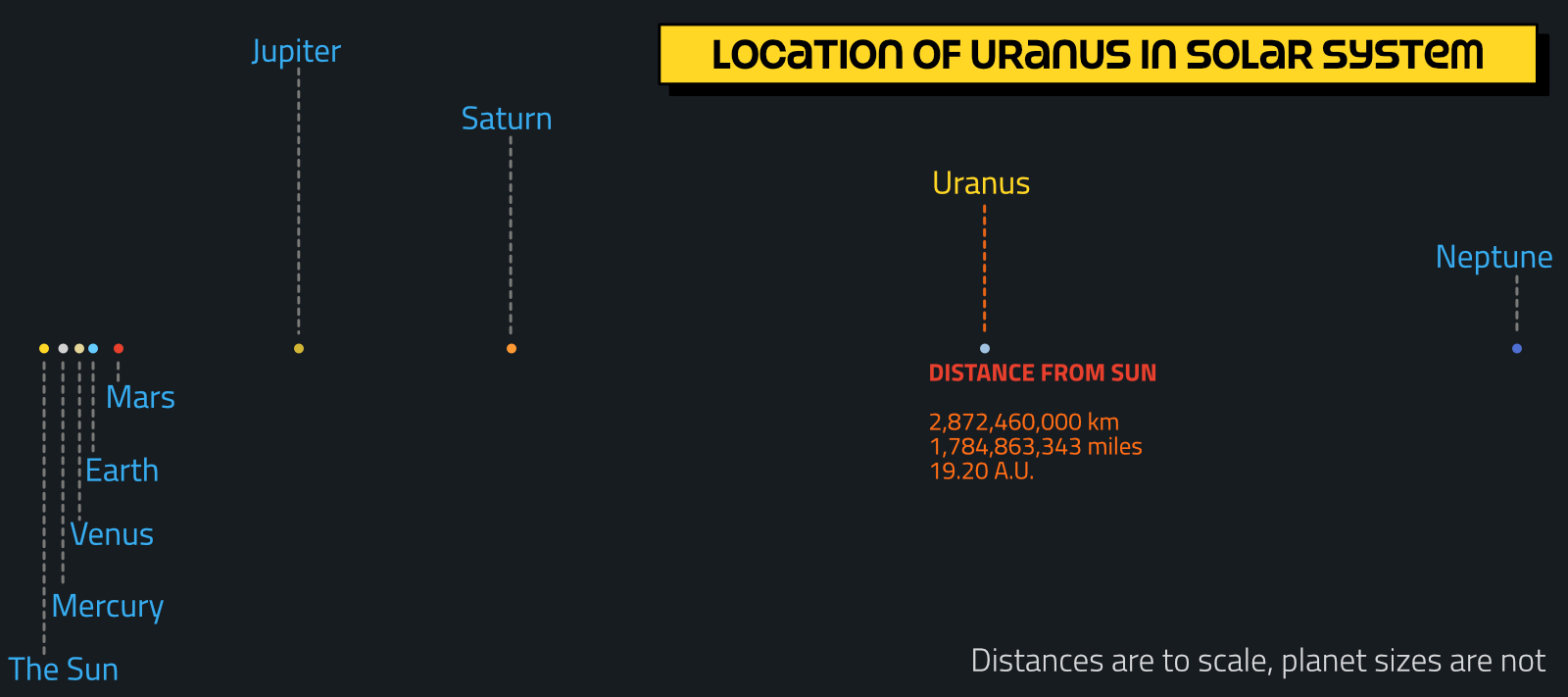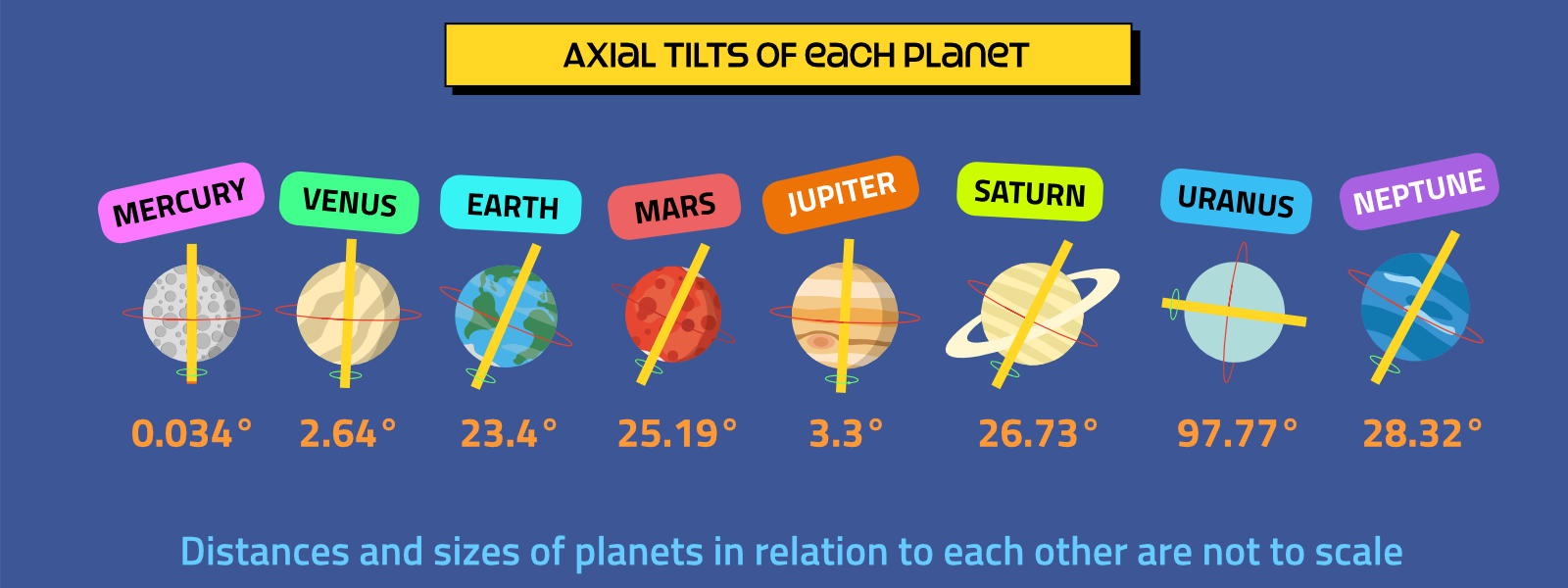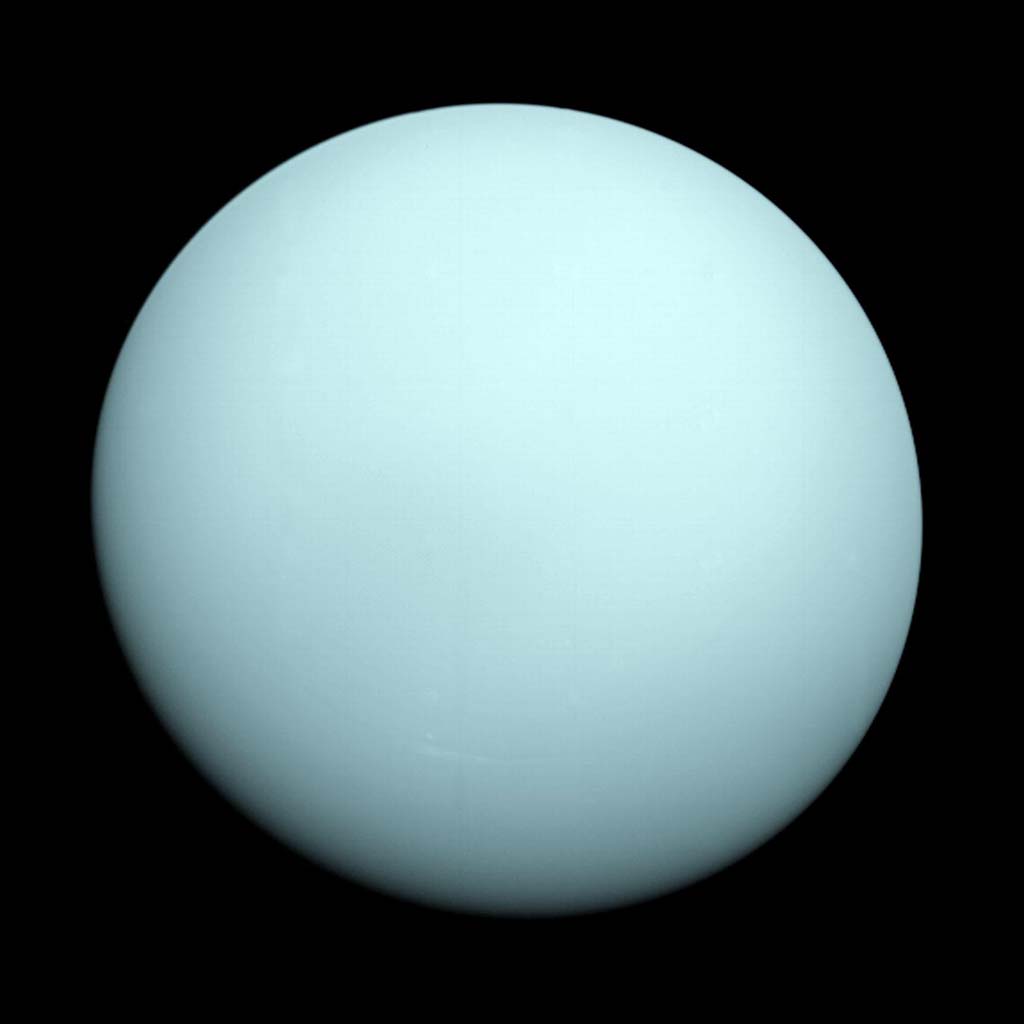Ten Facts about Uranus
Barely visible from Earth is a pale blue-ish spot called Uranus. This giant planet was unknown until it was discovered in 1781 by William Herschel. Here are some facts about the planet with the funny name.
Uranus is the seventh planet from the Sun in the Solar System
Uranus orbits the Sun at an average distance from the Sun of about 2.87 billion kilometres or 1.78 million miles. This is about 19 times further from the Sun than Earth is. The planet is so far away from the Sun that it is very difficult to see from Earth unless you are using a telescope or binoculars. Uranus' great distance from the Sun means it takes 84 years to complete a full orbit.
Uranus is the third largest planet in the Solar System
Uranus has a diameter of 50,724 km kilometers (31,518 miles). It is one of the gas giants, the four largest planets in the Solar System. These are Jupiter, Saturn, Uranus and Neptune. They are the four farthest planets from the Sun so are known as the outer planets. Uranus is slightly larger than its neighbour Neptune (49,244 kilometers / 30,599 miles) but much smaller than its other neighbour Saturn (120,536 km / 74,898 miles).
Uranus was the first planet to be discovered in the Solar System
Uranus was discovered on 13th March 1781 by the English astronomer William Herschel. Before its discovery, the Solar System was thought to contain six planets. Those were Mercury, Venus, Earth, Mars, Jupiter and Saturn. No one is credited as discovering those planets as their existence has been known since ancient times. Noboby knew of more planets simply because no others had been observed. The invention of the telescope made it possible to look deeper into space. Using his home-made telescope in his back garden in Bath, England, William Herschel spotted an object that he initially thought to be a comet, but which later turned out to be a planet. That planet became Uranus, and Herschel became the first person to discover a new planet in the Solar System.
Uranus hasn't always been called Uranus
When Uranus was first discovered, the task of choosing a name for it was given to its discoverer, William Herschel. Herschel decided to name his planet Georgium Sidus, which means George's Star. This was in recognition of the ruler of Britain at the time, King George III. Astronomers in other countries didn't like the idea of naming a planet after the ruler of another nation, with some referring to it as Herschel's Planet. Others preferred that it should have the name of a mythological god just like the other planets. German astronomer Johann Elert Bode proposed the name Uranus after the Greek god of the sky. This name eventually came to be widely accepted.
Uranus has 27 moons
There are 27 moons known to orbit Uranus. William Herschel discovered the first two in 1787, 6 years after he'd discovered the planet. Two more were discoverd in 1851 by William Lassell, an English beer brewer and astronomer. These four moons received their names in 1852, with names chosen by John Herschel, son of William Herschel. He chose Titania, Oberon, Umbriel and Ariel. Titania and Oberon are characters in Shakespeare's play A Midsummer Night's Dream. Umbriel and Ariel are characters in Alexander Pope's poem The Rape of the Lock. All other moons of Uranus discovered since then still get their names from the the works of Shakespeare and Pope.
Miranda could be a shattered reassembled moon
The fifth largest moon of Uranus is Miranda which was discovered in 1948 by Dutch-American astronomer Gerard Kuiper. Its surface features are unique as it contains canyons, ridges and craters, which some scientists think may be the result of objects colliding with Miranda, breaking it into fragments which then reassembled and reformed the moon.
Uranus orbits on its side
Uranus has the most tilted axis of any planet in the Solar System. Its angle of tilt is 98 degrees, making it seem like it's fallen over! Scientists think that this may be the result of an Earth-sized object colliding with Uranus in its early formation and knocking it over.
Uranus has rings
Like the other Gas Giants (Jupiter, Saturn and Neptune), Uranus has its very own sets of rings. These rings are very faint and were discovered on 10th March 1977 by James L. Elliot, Edward W. Dunham, and Jessica Mink onboard the Kuiper Airborne Observatory, a special aircraft that was equipped with scientific instruments which could make observations from Earth's skies. There are 13 rings known to orbit Uranus, made out of dark dust particles and rocks.
Voyager 2 is the only spacecraft to have visited Uranus
In 1986, the spacecraft Voyager 2 flew by Uranus. It sent back the first close-up images of the planet. Voyager 2 launched on 20th August 1977 on a mission to visit the outer planets. Prior to reaching Uranus, it had already been to Jupiter and Saturn and sent back stunning photos of both planets. It's quite likely that scientists would have been disappointed when they saw the featureless and bland images that Voyager 2 took of Uranus when it got there in 1986. Images from Voyager 2 also led to the discovery of 11 of its moons. After leaving Uranus, Voyager 2 visited Neptune in 1989. Voyager 2 is still operational at the distant edges of the Solar System.
Uranus' pale blue colour is caused by methane in its atmosphere
Uranus is known as a gas giant because it is a giant ball made up mostly of gas. Hydrogen and helium are the main gases in its atmosphere but it also contains smaller amounts of methane. Methane filters out red light which is why the planet appears a pale blue colour when viewed from a distance.








